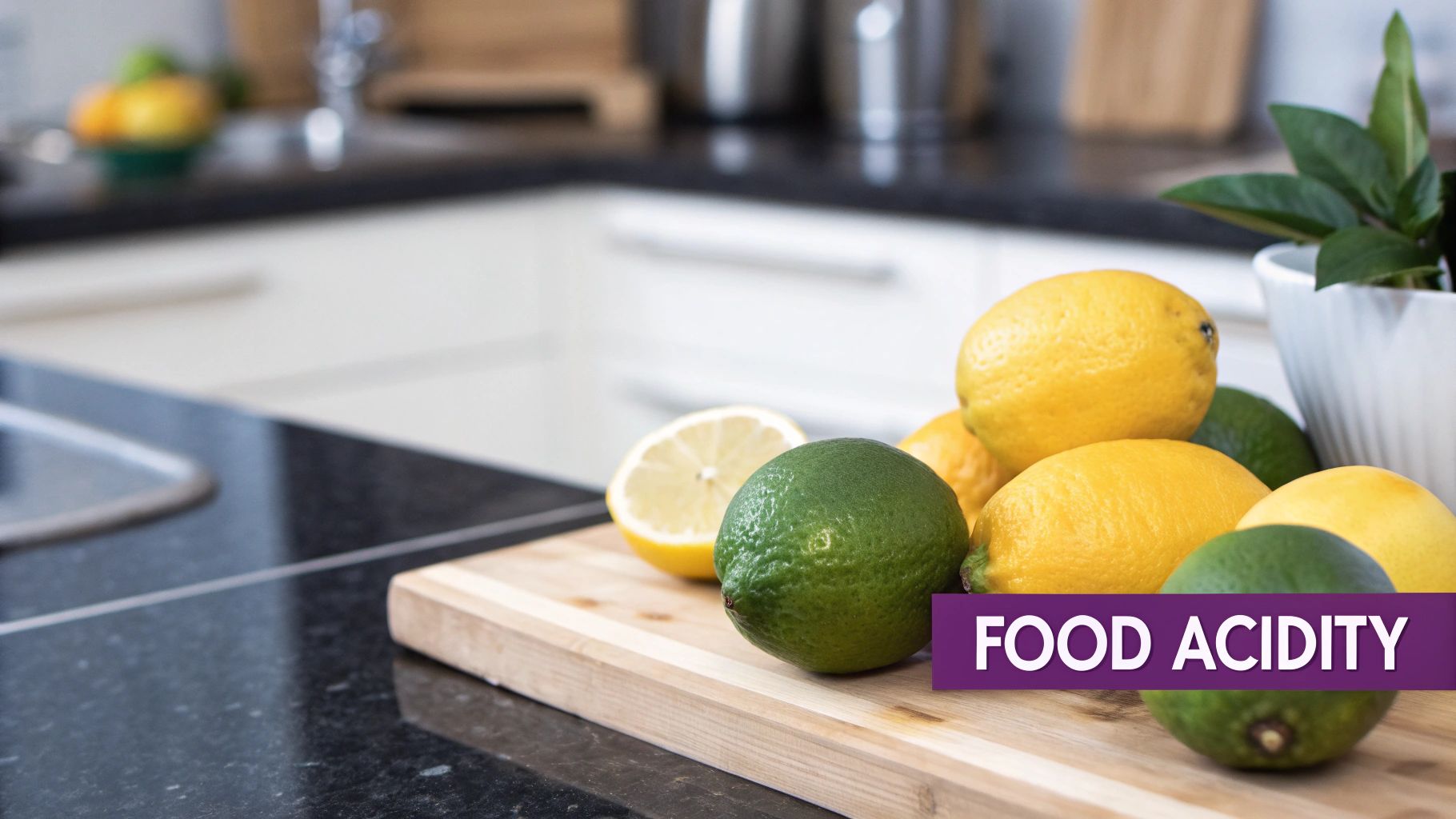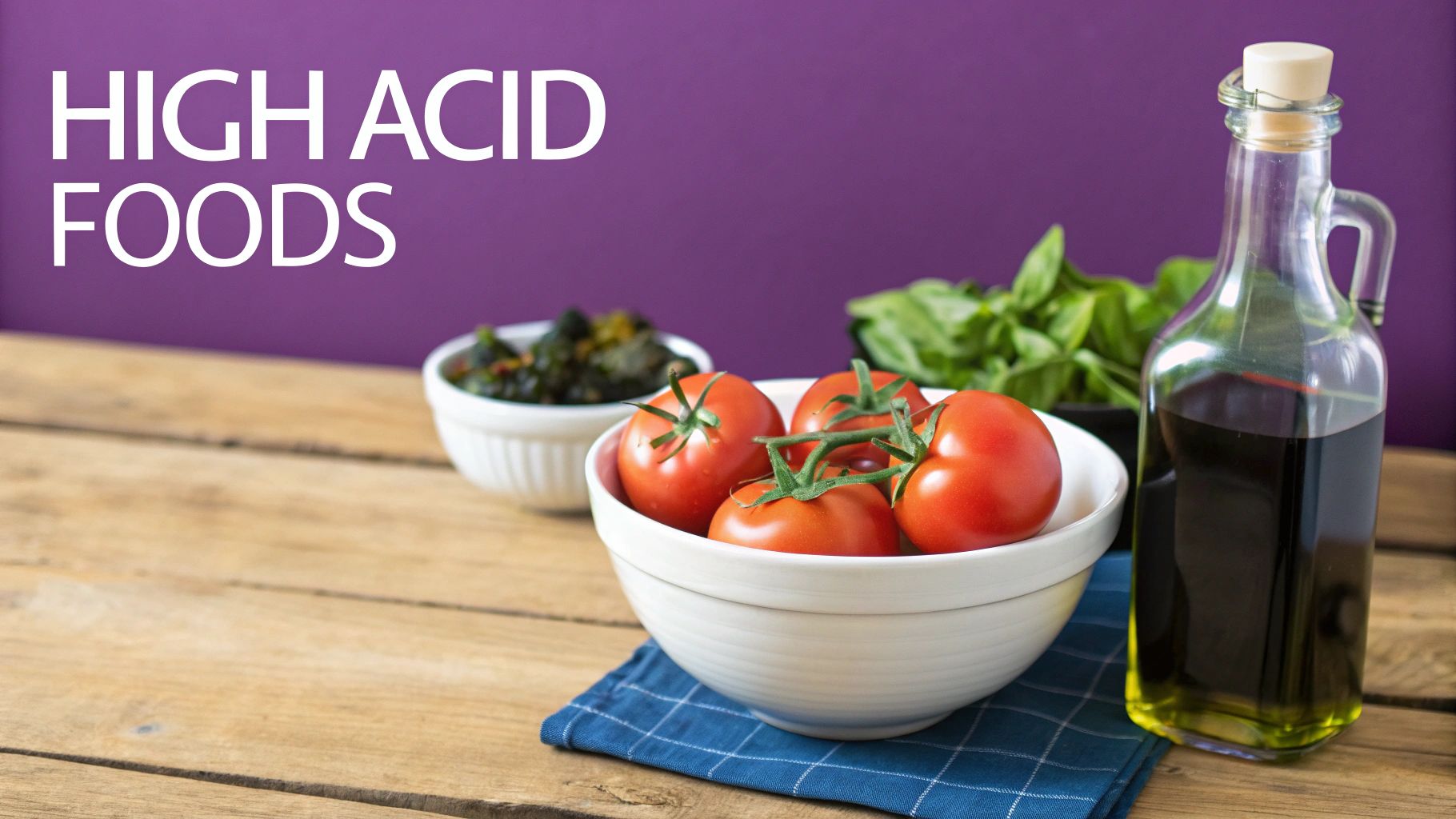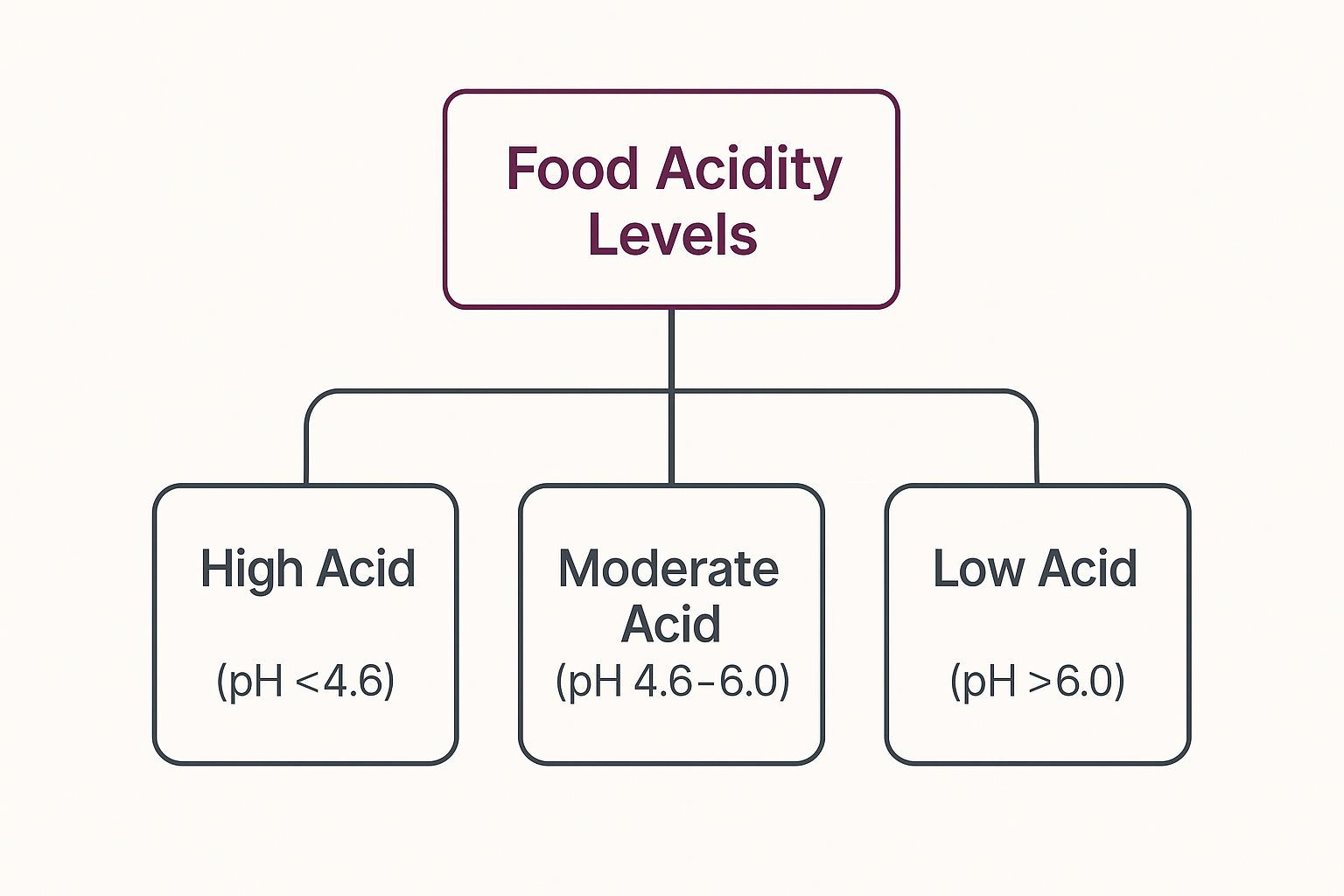
Your Guide to the Acid Food Chart and Alkaline Eating
An acid food chart is a straightforward tool that groups foods based on how they influence your body's pH after you've digested them. It's a simple way to see which foods are acid-forming (think meats and grains) and which are alkaline-forming (like most fruits and veggies).
Combining this knowledge with the right exercise habits is key to achieving your fitness goals. A balanced diet supports your body's energy and recovery needs, allowing your workouts to be more effective.
How to Use an Acid Food Chart for Better Health
Think of this chart less like a rigid set of rules and more like a roadmap for your diet. One of the biggest misconceptions is that a food's taste determines its effect. A classic example is a lemon—it's incredibly acidic to the taste, but it actually has an alkaline effect once your body metabolizes it.
What really matters is the "metabolic ash" left behind after digestion. Scientists measure this effect using a value called Potential Renal Acid Load (PRAL).

Here's how PRAL works: a positive PRAL score means a food is acid-forming, while a negative PRAL score means it's alkaline-forming.
Foods like meat and cheese tend to have higher, positive PRAL scores. On the flip side, most fruits and vegetables have negative PRAL scores, which helps your body balance its acid load.
When you pair a well-balanced diet with consistent exercise, you're creating a powerful one-two punch for hitting your health goals. For a deeper dive into making sense of food packaging, take a look at our guide on how to read nutrition labels.
A Quick Glance at Food Groups
Getting started doesn't mean you have to memorize the PRAL score of every single food item. The best approach is to simply get a feel for the general categories, which makes building more balanced meals much easier.
Here's a high-level table to help you visualize where common foods fall.
Quick Guide to Acid-Forming vs Alkaline-Forming Foods
| Food Category | Generally Acid-Forming | Generally Alkaline-Forming |
|---|---|---|
| Proteins | Meat, poultry, fish, eggs, most dairy | Almonds, tofu, whey protein |
| Fruits | Cranberries, plums (most are alkaline) | Lemons, limes, avocados, bananas, apples |
| Vegetables | Corn, lentils | Spinach, kale, broccoli, cucumbers, bell peppers |
| Grains & Starches | Wheat, rice, oats, bread, pasta | Quinoa, sweet potatoes, wild rice |
| Fats & Oils | Most are neutral, but some processed fats can be acidic | Avocado oil, olive oil, flax seeds |
| Beverages | Alcohol, soda, coffee, milk | Herbal tea, green juice, water with lemon |
Think of this chart as your practical starting point. By consciously trying to fill more of your plate with foods from the "Generally Alkaline-Forming" column, you can help ease the metabolic stress on your system. To support this balanced approach, mixing your post-workout shakes or green smoothies in our Premium Shaker Bottle ensures you're getting nutrients on the go.
Understanding Your Body's Natural pH Balance
Your body is an incredible self-regulating machine. It constantly makes tiny adjustments to keep everything in perfect balance. One of the most important things it manages is your blood pH, holding it steady within a very narrow, slightly alkaline window of 7.35 to 7.45. This is vital for all your bodily functions.
There's a popular myth that eating from an acid food chart will directly make your blood more acidic. Your body has powerful, built-in systems—especially your kidneys and lungs—that work around the clock to neutralize acids and keep your blood pH right where it needs to be.

So if you can't change your blood's pH, what's the point? The real goal is to reduce the metabolic load—basically, the amount of work—your body has to do.
Easing the Burden on Your Body
When your diet is heavy on acid-forming foods, your body has to go into overdrive to neutralize the acidic waste they leave behind. Your kidneys, in particular, get saddled with the tough job of filtering out all that excess acid.
The idea behind an alkaline-focused diet isn't to change your body's pH, but to make its job easier. You’re not trying to fundamentally alter your body; you’re supporting its natural design.
This simple concept is a game-changer when pairing your diet with exercise. When you ease the burden on your kidneys, you free up energy for better workout recovery and more stamina. For anyone with an active lifestyle, our Premium Shaker Bottle makes it simple to stay on track. It's perfect for mixing nutrient-dense green smoothies or recovery shakes on the go.
By making smarter food choices, you reduce the internal stress on your body, allowing it to focus its resources on building muscle and producing energy. It’s a powerful cycle where your diet and your fitness routine start working together, helping you hit your goals much faster.
The Complete Acid and Alkaline Food Chart
Let's get to the heart of it: a straightforward, easy-to-use acid-alkaline food chart. I’ve broken everything down into the categories you already know—Fruits, Vegetables, Proteins, and Grains—to take the guesswork out of planning your meals. This chart looks at foods based on how they affect your body after digestion.
This visual gives you a quick breakdown of where common foods land on the acidity spectrum.

As you can see, the most acidic foods are those with a pH below 4.6. Using this as a rough guide can help you build more balanced meals that support your energy levels, workout recovery, and overall wellness goals.
A Detailed Look at Food Categories
To give you an even clearer picture, I've created a comprehensive table that breaks down common foods by category and their potential pH impact. This is your go-to reference for making mindful choices at the grocery store and in the kitchen.
Detailed Acid and Alkaline Food List by Category
| Food Category | Highly Alkaline | Moderately Alkaline | Neutral | Moderately Acidic | Highly Acidic |
|---|---|---|---|---|---|
| Vegetables | Spinach, kale, cucumber, broccoli, bell peppers | Carrots, sweet potatoes, beets, celery, lettuce | --- | Corn, winter squash | --- |
| Fruits | Lemons, limes, avocado, grapefruit, watermelon | Apples, bananas, grapes, pears, oranges | --- | Blueberries, plums, cranberries, pomegranates | --- |
| Proteins & Dairy | Almonds, tofu, whey protein isolate | Lentils, most beans, pumpkin seeds, sunflower seeds | --- | Most nuts (walnuts, pecans), chickpeas | Beef, chicken, fish, eggs, milk, cheese, yogurt |
| Grains | Quinoa, amaranth, wild rice | --- | --- | Brown rice, oats | White rice, wheat, bread, pasta |
| Fats & Oils | Avocado oil, flax oil, coconut oil | Olive oil | Most other plant oils | Butter | --- |
| Beverages & Others | Green juice, herbal tea, lemon water, apple cider vinegar | --- | Filtered water | --- | Coffee, soda, alcohol, black tea, artificial sweeteners |
Keep this chart handy, but remember it's a guide, not a set of rigid rules. The goal is always balance and listening to what makes your body feel its best. For preparing nutrient-dense drinks like green juice or protein shakes, the Premium Shaker Bottle from dietexerciseshop.com is an essential tool for any health-conscious individual.
Where Common Foods Stand
Now, let's dive a little deeper into what this means for your daily plate.
Fruits and Vegetables
This group is the foundation of an alkaline-focused diet. A lemon tastes incredibly acidic, but it becomes alkaline-forming once your body metabolizes it. Leafy green vegetables are packed with minerals like potassium and magnesium that act as natural buffers against acidity.
Proteins and Dairy
This is where the balancing act comes into play. Most animal proteins are generally acid-forming. These foods are essential for muscle repair, so we don't want to cut them out. The trick is to pair these acid-forming proteins with a generous helping of alkaline vegetables. If you're looking for an eating style that nails this principle, our Paleo diet food list is a great resource.
Grains, Beverages, and Fats
Most grains are acid-forming but are also a key energy source. This doesn't mean you have to ditch your morning oatmeal. It just means being mindful of your portions.
The goal isn't to eliminate entire food groups; it’s about creating balance on your plate. A nutritious, acid-forming food like chicken breast is great for you. The key is to surround it with alkaline-forming foods—like a big pile of steamed broccoli—to create a well-rounded meal.
Why Do Processed Foods Tend to Be More Acidic?
Have you ever noticed how many packaged foods fall on the acidic side of the scale? It's not a coincidence. The reason often comes down to the ingredients added during manufacturing.
To make food last, manufacturers often use acidulants like citric acid and phosphoric acid. They're effective at controlling a food's pH, which helps stop bacteria from growing while keeping the taste and texture just right.

While these additives are vital for creating convenient, shelf-stable products, they also add to a food's total acid load once your body metabolizes it.
The Impact of Food Additives
Acidulants are everywhere in our food supply, and their use is only growing. The global market for these additives was valued at around USD 3.57 billion and is projected to climb to USD 4.46 billion by 2030. Citric acid is the clear frontrunner. You can dig deeper into the global food acidulants market trends to see the full picture.
This means a diet heavy on processed foods naturally carries a higher acid load. Knowing this can change how you look at the aisles in the grocery store. It makes sense why choosing more whole, unprocessed foods can make a big difference.
Moving toward a whole-foods lifestyle is a powerful step. To help you transition away from processed options, our Premium Shaker Bottle from dietexerciseshop.com is the perfect tool for mixing up nutrient-packed smoothies and protein shakes on the go. It's a simple way to get the good stuff in as you work toward a healthier you.
Potential Health Benefits of an Alkaline Diet
Shifting your diet to include more alkaline foods isn't really about changing your body's overall pH. Instead, the real magic comes from what these foods do for your system—they ease the metabolic load and push you toward a healthier, whole-foods lifestyle.
Think of it as giving your body a helping hand. When you consistently choose foods from the alkaline side of the chart, you're directly supporting your body's natural balancing act.
Supporting Your Body From Within
A diet loaded with fresh fruits and vegetables delivers essential minerals like potassium and magnesium. These are critical for maintaining strong bone density. If your diet is too acidic, your body might have to "borrow" calcium from your bones to neutralize the acid.
This approach is also a game-changer for preserving lean muscle mass. An overly acidic internal environment can contribute to muscle breakdown, so a more alkaline-focused diet helps you protect the muscle you've worked so hard to build in your workouts.
The core idea is simple: provide your body with the right tools (alkaline-forming foods) to maintain balance more efficiently. This allows it to direct resources toward recovery, energy, and strength.
Gut Health and Nutrient Absorption
A healthy gut is the foundation of overall wellness. Many alkaline-forming foods are packed with prebiotics—the stuff that feeds your good gut bacteria.
Improving intestinal health is a massive focus in nutrition. The global market for food-grade butyric acid, known for its positive impact on gut function, is projected to soar past USD 1.17 billion by 2035. You can learn more about the rising demand for beneficial food acids.
Eating well is only half the battle; you also have to absorb those nutrients. Our Premium Shaker Bottle from dietexerciseshop.com is the perfect tool for mixing smooth, nutrient-packed shakes that support your digestive system. It’s an easy way to complement an alkaline-focused diet and help you hit your fitness goals.
Got Questions About Alkaline Eating? We've Got Answers.
Jumping into the world of alkaline diets can spark a few questions, especially when you’re trying to sync up your diet with your workouts. Let’s tackle some of the most common ones.
Can My Diet Actually Change My Body's pH?
This is the big one, and the answer is a firm no. You can't change your blood's pH with food. Your body has sophisticated systems in place to keep your blood pH locked in a very narrow, stable range.
The goal of an alkaline-focused diet is to lighten the acid load on your body. When you eat more alkaline-forming foods, you give your kidneys a break from working overtime to neutralize metabolic acid.
If a Food Tastes Acidic, Is It Acid-Forming?
It’s an easy mistake to make, but a food’s taste doesn't dictate its effect on your body. Lemons, for example, taste acidic but are alkaline-forming once your body processes them.
The acid food chart is based on the Potential Renal Acid Load (PRAL) score, which measures this post-digestion impact.
What’s the Right Balance of Alkaline to Acidic Foods?
A great rule of thumb is to aim for a plate that’s about 70-80% alkaline-forming foods and 20-30% acid-forming foods. This approach naturally leads you to a diet packed with vegetables and fruits while still making room for essential proteins and grains that fuel your workouts.
How Does Exercise Play Into All of This?
When you push yourself through a tough workout, your body produces lactic acid. This can temporarily lower the pH inside your muscle cells and contribute to fatigue.
This is where your diet can be a powerful ally. Fueling your body with plenty of alkaline-forming foods provides minerals like potassium and magnesium that help your system neutralize this exercise-induced acidity. It’s a perfect example of how smart nutrition and consistent training work hand-in-hand.
Here at Diet and Exercise, we know that understanding the "why" behind your choices is empowering. When you combine the knowledge from an acid food chart with the right fitness gear, you're setting yourself up for success. Check out our collection of apparel and equipment designed to support you every step of the way. Explore our full range of products at dietexerciseshop.com.
